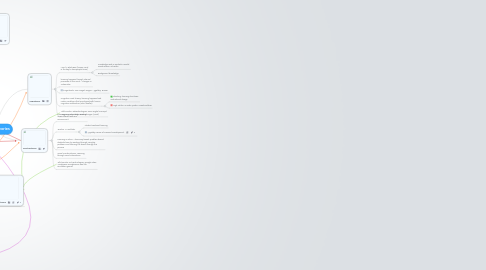
1. Teachnology
1.1. A teachers philosophy on integrating technology with learning.
1.2. how to use technology in teaching practices
2. TPACK
2.1. Technological, Pedagogical, Content Knowledge
2.2. A Venn diagram explaining the nature of knowledge required for 21 century teachers in terms of technology integration, content expertise, and pedagogical strategies.
2.3. Intersection of Tech knowledge, pedagogical knowledge, content knowledge --- NOT each one in isolation
2.4. " ...good teaching requires an understanding of how technology relates to the pedagogy and content."
2.5. Redefining curriculum through integration of technology to suit the needs of the current digitally engaged learner.
2.6. TPACK VENN
2.7. framework that identifies various domains
3. Behaviourism
3.1. Mind = Tabula Rasa (Blank Slate)
3.1.1. Environment determines the behaviour
3.2. learning happens through external stimuli
3.2.1. Students can be trained by reward and Punishment -- behaviour training
3.3. Direct Instructions in clasroom: Teacher-centered instruction
3.3.1. Learning is passive - students must learn the correct response.
3.4. Behaviourists: Ivan Pavlov, John B. Watson, Edward Thorndike and B.F. Skinner
3.4.1. Pavlov's Dog Experiment
3.5. MOTTO: "Practice makes Perfect!"
3.6. Ed Technologies: Digital Games for Learning (Reward-based), TED Talks (teacher centered)
4. Connectivism
4.1. Learning is creating networks and making connections
4.1.1. “…forget about trying to ‘know’ everything; instead, build your network of knowledge sources, and access them whenever you need them.” Ryan Tracey
4.2. Knowing how and where to find information instead of knowing the information is valued more
4.2.1. emphasis on accurate current information instead of dated.
4.3. values diversity of opinions -- instigates critical thinking and widening perspectives
4.4. Learning in a Digital Era
4.4.1. Teacher as a resource, connection
4.4.2. interdisciplinary
4.4.3. global and real-time
4.5. Ed Technologies: MOOC, Twitter, LinkedIn, Facebook, TED, Online Forums, Searches -- The Internet!
4.5.1. Life-long Networked Learning!
4.6. Key theorists: George Siemens and Stephen Downes http://www.connectivism.ca
5. THEORIES
5.1. Technology Theories
5.1.1. Media Ecology
5.1.1.1. technology an integral part of human existence
5.1.1.1.1. roles and responsibilites
5.1.1.1.2. media culture and etiquette
5.1.1.1.3. Neil Postman
5.1.2. Social Construction of Technology (SCOT)
5.1.2.1. The study of understanding how social contexts influence technology
5.1.2.2. Popular technology vs. Rejected Technology
5.1.2.2.1. for example: why people moved on from Orkut to Facebook. Why people rejected BBZ10 whereas Apple products prevail the same market
5.1.2.2.2. Who in the society determines "acceptance" or "rejection" of tech.
5.1.2.3. Why Better Technology Doesn't Always Win: SCOT view video: http://tinyurl.com/n4rj7jd
6. Problem-based learning -- Authentic Tasks where students work through real-world problems to learn basic concepts.
7. Cognitivism
7.1. Mind = Black Box (human mind is the key to how people learn)
7.1.1. Knowledge rests in symbolic mental constructions: Schemas
7.1.2. Background knowledge
7.2. learning happens through internal processes in the mind -- changes in Schematas
7.3. Cognitivists: Jean Piaget, Gagne, Vygotsky, Bruner
7.4. Cognitive Load Theory: learning happens best under conditions that are aligned with human cognitive architecture.(John Sweller)
7.4.1. chunking, learning structures, instructional design
7.4.2. High Falutin' mumbo jumbo, overstimulation
7.5. EdTechnologies: Prezi, Digital Concept Mapping, One Note, Track Changes (Word)
8. Constructivism
8.1. Learning is constructing meaning as we interact with our environment.
8.2. Teacher = Facilitator
8.2.1. student-centered learning
8.2.2. Vygotsky's Zone of Proximal Development
